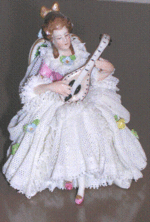Porcelain
|
|

| Contents |
Chinese porcelain
Chinese porcelain is made from a hard paste comprised of the clay kaolin and a feldspar called petuntse, which cements the vessel and seals any pores. China is high-quality porcelain. Most china comes from the city of Jingdezhen in China's Jiangxi province.
History
Jingdezhen, under a variety of names, has been central to porcelain production in China since at least the early Han Dynasty. Earliest techniques were very primitive, barely above the level of standard pottery. By the time of the Southern and Northern Dynasty period, however, techniques and materials had been improved to the point that Jingdezhen clay was refined into porcelain.
The Sui and Tang Dynasties introduced high-temperature kilns, resulting in pure, translucent whites, attractive to the eye, as well as a variety of advanced glazing techniques. These improvements produced smooth, durable porcelain ware. The resulting product was often referred to as "false jade".
Techniques
The most noticeable difference between porcelain and the other pottery clays is that it 'wets' very quickly (that is, added water has a noticeably greater effect on the plasticity for porcelain than other clays), and that it tends to continue to 'move' for longer than other clays, requiring experience in handling to attain optimum results.
Porcelain clays can be chemically formulated for strength, plasticity and durability to the point that they can be used as throwing bodies. Porcelain ware was produced on the potter's wheel in many historic cultures, including China and Japan. Many categories of glazes, e.g. celedons, were formulated specifically for their striking effects on porcelain. Modern potters also produce porcelain ware, and generally believe these clay bodies challenge production, firing and glazing skills. Commercially formulated procelain bodies are generally available through most clay distributers.
Porcelain ware of all types is typically biscuit fired at around 1000 degrees Celsius (1800 degrees Fahrenheit), and glaze fired (the final firing) at 1300°C (2300°F) or higher.
See also
Japanese porcelain
European porcelain
The European porcelain was invented in Dresden and Meissen in Saxony, Germany, in the reign of the Elector Augustus the Strong (1694-1733), where today can also be found the largest porcelain collection in the world. For over 200 years European alchemists had unsuccessfully tried to discover the secret of the Japanese and Chinese porcelain masters, until Augustus set out to discover the hidden process. Johann Friedrich Böttger finally unearthed the recipe to cure Augustus of his obsession with "White Gold".
The Europeans used a soft paste, which makes for weaker porcelain than the Chinese method. To compensate, around 1750 the English began to use calcined bone ash to strengthen their porcelain, with the resulting material (typically comprising 25% to 50% bone ash) becoming known as bone china.
Key people and places
- Gshel, Russia
- Josiah Wedgwood
- Limoges, France
- Meißen, Germany
- Herend, Hungary
- Pécs, Hungary
- Porsgrunn, Norway
- Sèvres, France
- Worcester, England
- Delft, Netherlands
References
External links
Chinese Porcelain:
- Chinese porcelain (http://www.liverpoolmuseums.org.uk/ladylever/collections/chinaart.asp) at the Lady Lever Art Gallery
- Jingdezhen attractions (http://www.travelchinaguide.com/attraction/jiangxi/jingdezhen/index.htm)
- Jingdezhen: Ceramics Metropolis of China (http://www.chinavista.com/experience/jingdezhen/jingdezhen.html)
- Jingdezhen Special Folk Arts Porcelain Research Institute (http://www.china-article.com/indexe.htm)af:Porselein
de:Porzellan eo:Porcelano fr:Porcelaine io:Porcelano he:חרסינה nl:Porselein ja:陶磁器 pl:Porcelana ru:Фарфор
